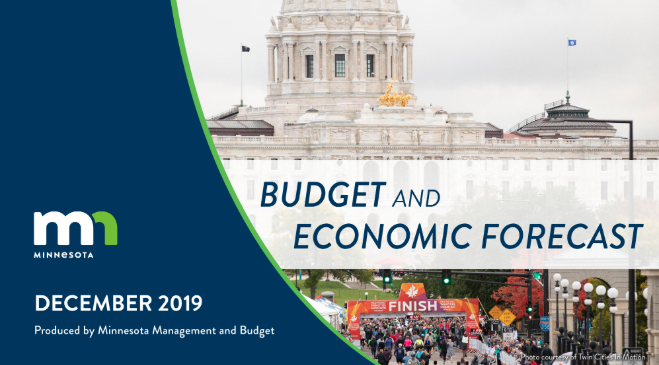Projected $1.3B state surplus could be good news for clean water
In a delightful bit of news, the State of Minnesota’s December 2019 budget forecast estimates a $1.3 billion preliminary state budget surplus for 2020. While sure to ignite debates regarding both new investments and planned tax cuts during the 2020 Legislative session, this could bode well for much-needed clean water funding.
How we got here
As you may recall, the 2019 legislature went into overtime to finalize a two-year, $48.5 billion state budget. That overall budget includes a variety of assumptions about both revenues and expenses over the biennium.
Twice yearly (November and February) the Minnesota Management and Budget releases updated forecasts about Minnesota’s economic and budget outlook – their best estimate of future revenues and expenses based on changing economic conditions.
Gov. Tim Walz and the Legislature use the forecast to manage the state’s budget and plan for the future. While the estimated $1.3 billion surplus could rise or fall depending on a variety of factors, it serves as an important waypoint as Minnesotans evaluate the budget and tax policy options for the coming year.
Looking ahead
With the governorship and House under DFL control and the Senate under Republican control, the 2020 session could reprise the at-times bitter budget divides of the 2019 session.
Meanwhile, a laundry list of underfunded initiatives, from health care and education to the environment and transit, are likely to be considered amid an unexpectedly rosy short-term financial outlook.
A word of caution
While we're delighted at this budget forecast, it's important to remember that it does not represent actual cash resources available to the Legislature in 2020.
As recent history shows, a forecasted surplus in early December can look very different by the time the Legislature convenes in February.
Much of the money is also already spent, so to speak. By law, a significant share of any surplus cash will go to the state’s budget reserve to ensure its balance meets official recommendations. And, oddly enough, the budget forecast doesn’t account for inflation, which could consume much of what remains. (With the notable exception of consumer electronics and technology, there are few products and services that tend to get cheaper over time.)
A variety of outside local, national and global factors — a slowing economy, trade conflicts, political upheaval and even harsh winter weather — can rapidly influence the state’s economic outlook.
Nevertheless, a surplus does represent an important opportunity to invest in clean water.
It's time to invest in clean water
As the Legislature and Gov. Tim Walz consider their options, FMR and our allies across the state will be working hard to remind them that most of Minnesota’s waters are impaired and farms are struggling, but there are programs that put both on a long-term path to health.
That’s why we continue to lead efforts to advance new crops or cropping systems like Kernza, a perennial wheat recently featured on PBS News Hour, and Camelina, a winter cover crop that can be harvested and sold before the next summer’s crop goes in. These crops can reduce land and water pollution and increase farm profits – exactly the kind of win-win that Minnesota deserves.
In addition, the budget surplus estimates are also good news for important programs to reduce chloride (salt) pollution, protect drinking water, invest in water infrastructure, and our other 2020 legislative priorities. Speaking of which, we're in the final stages of setting our legislative agenda. Look for a full summary in January, when the water blog transitions back to FMR's "Legislative updates" blog.
Become a River Guardian
FMR's water program is working with partners across the state to address many water pollution and public health issues — including efforts to help farmers protect our water and their bottom line.
Sign up as a River Guardian and we'll email you when there's a chance to act quickly online for the river. Plus, you'll be invited to special events like educational happy hours.
